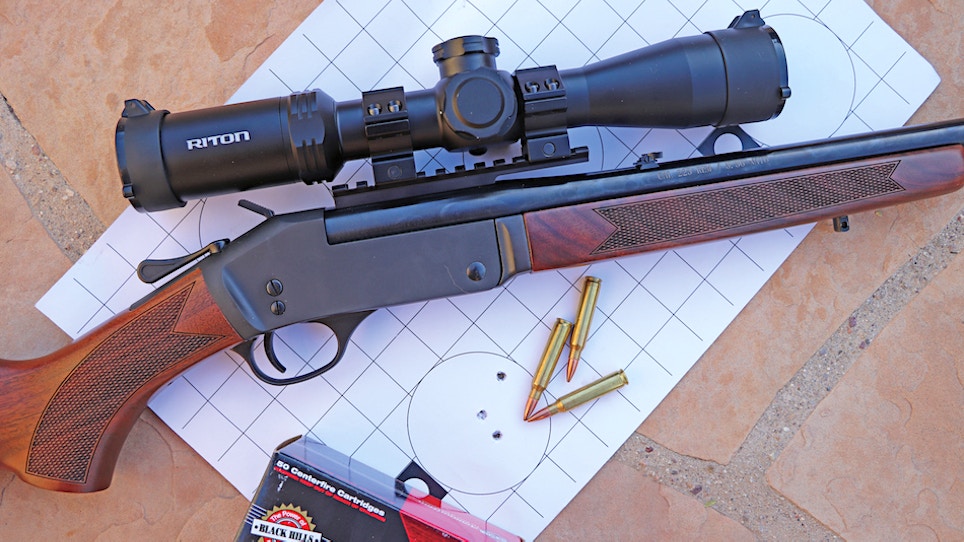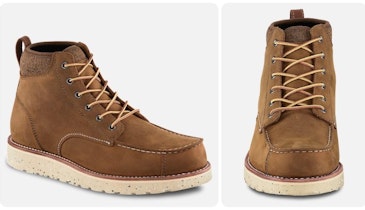
Henry Repeating Arms built its name and reputation on its line of lever-action rifles. But the folks there zeroed in on the limited number of mid-priced, quality, single-shots on the market and responded with a model that the company aptly calls the Single Shot. (Photo: Scott Mayer)
You may be familiar with the axiom, “Beware the man with one gun; he probably knows how to use it.” At a more granular level, the same can be said for the man (or woman) with one shot; he or she knows not to waste it. That’s the nostalgic appeal of a single-shot rifle — it puts you to the challenge with no quick follow-up shot as a backup plan.
Unfortunately, there aren’t many mid-priced, single-shot rifles out there for someone willing to pick up the one-round challenge and who wants a gun that can be passed on to future generations. At one end of the single-shot spectrum, you have the “budget” guns that are certainly functional, but utilitarian in appearance. Those are usually imports and often marketed toward youth as their first gun.
At the other end, you have primarily expensive replica arms that follow classic patterns such as Rolling Blocks, High and Low Walls and Sharps. There’s not much in the middle. Thompson/Center has a good selection and Ruger offers the No. 1, but the Rugers are only available in select, limited edition models each year.
Henry Repeating Arms built its name and reputation on its line of lever-action rifles. But the folks there zeroed in on the limited number of mid-priced, quality, single-shots on the market and responded with a model that the company aptly calls the Single Shot.
“We didn’t enter the single shot category to see if we could build a budget gun in a race to the bottom. That’s just not the way we do things,” says Dan Clayton-Luce, communications director for Henry. “We entered the single shot category to build premium single shot rifles and shotguns that punch well above their price point to deliver performance and value. It fits snugly between the more budget-oriented options on the market and the very pricey replica options.”
According to Clayton-Luce, his ideal Single Shot customer is someone who is going to understand its limitations and accept the challenge of only carrying one round on board.
“When all is said and done,” he says, “all it takes is one shot to do the job. Make that one shot count and you’ll never have a need for a follow-up shot. Once you get past the idea of only being able to fire one shot before needing to reload, you’re then able to appreciate the simplicity of the action, the lighter weight and the sleek profile.”
Two Variants
There are two variants of Henry’s Single Shot — one a matte black steel frame and one a hardened and polished solid brass frame. The steel frame is available in seven different chamberings while the brass is available in only three.
There are also shotgun models, and all are made in the U.S.A. at Henry’s Rice Lake, Wisconsin, facility. These Single Shots exemplify what shooters have come to expect from Henry; well-figured American walnut stocks, elegant simplicity and quality workmanship.
“The fit and finish of the wood and steel are probably what surprises people the most when they pick the rifle up and handle it,” says Clayton-Luce. “We definitely put a lot of effort into the assembly and that’s evident to anyone who gets their hands on any one of our firearms, but especially the Henry Single Shot.”
Mechanically, there’s not much to a break-open single-shot (lock-up is a single bite and locking block), but what there is, Henry did right. For one thing, the top lever is easy to manipulate. There’s no heavy spring pressure to overcome like you may be used to on other break-opens and the lever is even dual-directional so you can press it either right or left to open the action.
The Single Shot has an external, rebounding hammer that you have to manually cock, which means that when you break open the gun, you’re not doing so against spring resistance to cock anything. As with the top latch, the gun breaks open and closes effortlessly.
When thumbing back the hammer, I have to admit that the spur is a little thin and digs into the pad of your thumb, but that’s easily taken care of with a hammer extension. The single-stage trigger is crisp, but on the sample ranged between five and six pounds pull.
Most Henry rifles come with iron sights; the Single Shot is no exception. It has an adjustable flip-up rear sight and brass bead front. While that sight arrangement may be fine for this rifle in larger calibers and for bigger game, most predator hunters probably are going to want to mount a scope. To that end, the Henry Single Shot is drilled and tapped to take a Weaver 82 base sold separately by Henry.
My Setup and Results
I initially topped the .223-Rem.-chambered Henry with a Trijicon 2.5-12.5x42mm AccuPoint scope, but ran into problems with the gun’s low profile and rebounding hammer. Because the hammer is rebounding, when it is at rest it’s positioned slightly back from contact with the firing pin. While there was (just) enough room between the top of the hammer spur and the ocular bell of the scope for me to cock the hammer, when it came time to pull the trigger, the hammer’s full range of forward travel was stopped when the top of the spur struck the ocular bell instead of making its way all the way to the firing pin. This prevented the gun from firing.
This was not a malfunction; it was just an incompatibility between the gun and scope (more accurately ring height) that I should have thought about before heading to the range. I considered using the iron sights, but the scope base sits a little high to see the rear sight and at the range I did not have the appropriate size Torx wrench to remove the base. Fortunately, I also was testing a slug gun that day that I had fitted with a Riton RT-S Mod 5 3-9x40mm scope. Since both guns utilized a Picatinny rail-type of scope base, it was a simple matter to switch the Trijicon for the Riton. It sat slightly higher, so the hammer cleared the scope and I was back in action.
For loads, I used Hornady’s 55-grain spire point and a Black Hills load with 69-grain Sierra MatchKing bullets. I thought the Black Hills load might be a little sketchy regarding accuracy because the .223 Rem.-chambered Single Shot has a 1:9-inch twist and these heavier bullets might not stabilize. But it turned out to be the more accurate load, averaging 1.38 inch for five, consecutive three-shot groups at 100 yards. The Hornady load wasn’t far behind, averaging 1.53 inch.
There were no malfunctions. Even case extraction (no small feat on a break-open and rimless bottle-neck cartridge) was positive. There is one functional characteristic worth noting on the Single Shot. It has an interlock, so if you cock the hammer with the action open you cannot close the action. Likewise, if the hammer is cocked, you cannot open the action.
If user comments on various message boards and online comment sections are any indication, Henry probably has another winner with the Single Shot. Michael Haley posts, “I am extremely pleased with the fit, finish and appearance of my rifle and have no regrets about this purchase. Once again Henry has delivered a fine product!” Sean David Woodburn writes, “[T]his gun has nicer features and finish than any single shot rifle on the market under $1,000.” A post from firstcavb229 titled“Really Impressed” and said, “Good old school rifle-making. I have no interest in plastic and aluminum. I only buy steel and walnut. If you are looking for a quality single shot this is the choice.”
Clayton-Luce added that the only complaints he’s heard are from those who want a different chambering from what Henry offers. “[E]veryone has a favorite caliber and sometimes it’s not one that we’re currently offering,” he says. “We’re always paying close attention to these types of questions though to see which calibers are mentioned the most.”
Granted, Henry makes a great product, but what really sets Henry apart is the pride you see in everything about Henry. “Made in America or not made at all,” a lifetime guarantee, great customer service and action smoothness are just some of the things Henry can hang its hat on.
“We’ve proven over the last 20 years that if someone decides to spend their hard-earned money on a Henry rifle or shotgun, we’re going to make sure they’re 100 percent satisfied,” says Clayton-Luce. “Most of the time that’s achieved right when the customer opens the box and pulls out their new firearm, but we stand behind every firearm we sell for life.”
For more information: www.henryusa.com





